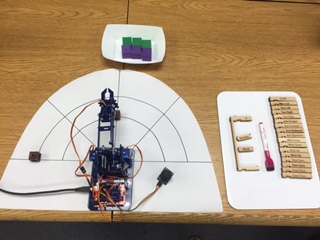Robot Problem Solving for Elementary, Middle, and High-School Students: Programming Without Computers
Abstract: Computing education is becoming a critical component for success in the modern job market. President Obama’s 2016 State of the Union highlighted computing as a national priority of K-12 education. The experience and training required are a barrier to the introduction of courses or other educational models with computing content. In this proposal, we propose to design a robotics module for outreach to Nevada schools and pilot its use in several Title 1 schools.
Details
- Organization: Nevada Space Grant Consortium (NV-SGC)
- Award #: NNX15AI02H
- Amount: $4,889
- Date: Feb. 1, 2016 - April 30, 2016
- PI: Dr. David Feil-Seifer
Supported Publications
- Anderson, M., Miller, B., Kirn, A., Jurkiewicz, M., & Feil-Seifer, D. Making in the Middle: Robots and Sequences. In ScienceScope, Feb 2019. ( details ) ( .pdf )
- Miller, B., Anderson, M., Major, J., Jurkiewicz, M., Kirn, A., & Feil-Seifer, D. Unplugged Robotics to Increase K-12 Students' Engineering Interest and Attitudes. In Frontiers in Education, San Jose, CA, Oct 2018. ( details ) ( .pdf )
Supported Projects
Robotics in the Classroom Jan. 1, 2014 - Present
 Robotics represents one of the key areas for economic development and job growth in the US. However, the current training paradigm for robotics instruction relies on primarily graduate study. Some advanced undergraduate courses may be available, but students typically have access to at most one or two of these courses. The result of this configuration is that students need several years beyond an undergraduate degree to gain mastery of robotics in the academic setting. This project aims to: alter current robotics courses to make them accessible for lower-division students; increase both the depth and breadth of the K-12 robotics experience; increase the portability of robotics courses by disseminating course materials online, relying on free and open-source software (FOSS), and promoting the use of simulators and inexpensive hardware. We will team with educators to study the effectiveness of the generated materials at promoting interest in robotics, computing, and technology at the K-5, 6-8, 9-12, and undergraduate grade levels.
Robotics represents one of the key areas for economic development and job growth in the US. However, the current training paradigm for robotics instruction relies on primarily graduate study. Some advanced undergraduate courses may be available, but students typically have access to at most one or two of these courses. The result of this configuration is that students need several years beyond an undergraduate degree to gain mastery of robotics in the academic setting. This project aims to: alter current robotics courses to make them accessible for lower-division students; increase both the depth and breadth of the K-12 robotics experience; increase the portability of robotics courses by disseminating course materials online, relying on free and open-source software (FOSS), and promoting the use of simulators and inexpensive hardware. We will team with educators to study the effectiveness of the generated materials at promoting interest in robotics, computing, and technology at the K-5, 6-8, 9-12, and undergraduate grade levels.
